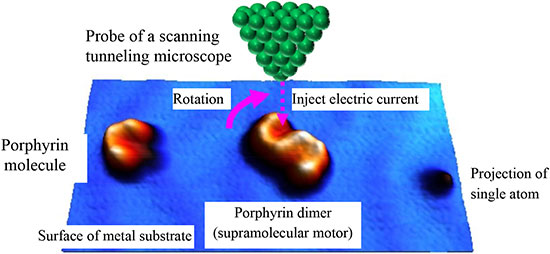| Posted: Sep 01, 2015 |
Manipulating the rotational direction of artificial molecular motors using supramolecules
(Nanowerk News) A research group consisting of Takashi Uchihashi, MANA Scientist, Jonathan Hill, MANA Scientist, Tomonobu Nakayama, Unit Director, and Christian Joachim, MANA Principal Investigator (also a group leader at the CEMES-CNRS, France), at the NIMS International Center for Materials Nanoarchitectonics (MANA), along with a research team led by Professor Teruo Ono at the Institute for Chemical Research of Kyoto University, jointly fabricated molecular motors on a metal substrate using supramolecules, and successfully reversed rotation of molecular motors by rearranging bonding between molecules that constitute a supramolecule.
|
|
A molecular motor is a kind of nanomachine vital in sustaining everyday activities of living organisms. It is a dream of nanotechnology researchers to fabricate a mechanical system driven by nanomachines in the same manner that biological systems develop molecular motors in a self-organizing fashion. While molecular motors already have been created on substrate surfaces using organic molecules, they had a major issue in that they were incapable of switching their rotational direction. This issue is caused by their structural rigidity associated with strong bonding among the molecules that comprise a motor.
|
 |
| Conceptual diagram showing a molecular motor in action. A porphyrin dimer rotates in the direction indicated by the solid arrow through injection of electric current into the dimer from the probe of a scanning tunneling microscope.
|
|
In this study ("Current-Driven Supramolecular Motor with In Situ Surface Chiral Directionality Switching"), the joint research team fabricated structurally flexible molecular motors using a supramolecule, and succeeded for the first time in manipulating the rotational direction of the motors. A supramolecule has a complex structure, consisting of several molecules that are loosely connected to each other by hydrogen bonds and/or other kinds of weaker bonds relative to covalent bonds. A motor made of a supramolecule rotates in one direction when electric current is injected into the molecule.
|
|
In addition, the team succeeded in reversing the motor’s rotational direction by rearranging motor parts via application of electric current under certain conditions. The team accomplished this because supramolecule-comprising molecules were bonded by moderate strength, which is neither too strong nor too weak. Moreover, since the team applied the principle of self-organization in biological systems to the fabrication of molecular motors, they believe that mass production of the products is feasible.
|
|
Building on these positive outcomes, the team will aim to create nanomachines with superior functionality at a larger scale. Also, studies on the behavior of artificial molecular motors may help understand the detailed mechanism of how naturally-occurring molecular motors in biological systems work.
|
|
This study was conducted as a part of a Grant-in-Aid for Challenging Exploratory Research program titled “Creation of a new molecular motor based on the Einstein-de Haas effect” (Takashi Uchihashi, principal investigator).
|

